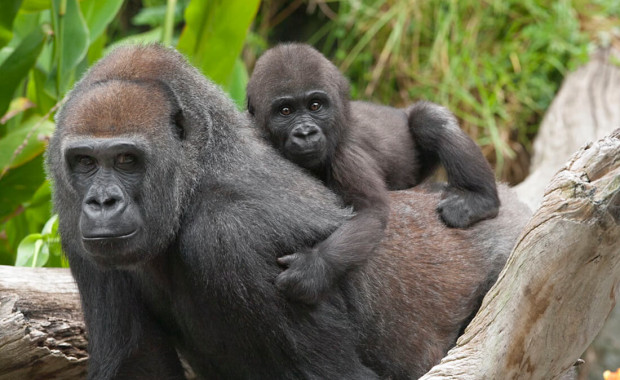It appears that humans aren’t the only species to be afflicted with heart disease. Animals in captivity are too. In fact, heart disease is the number one killer of male Western lowland gorillas in North American zoos.
Brooks, a 21-year-old gorilla, died of heart failure at an American Zoo in 2005. Following the death of Brooks, researchers decided to take a closer look at the health and lifestyle of zoo gorillas in an attempt at preventing others from succumbing to heart disease.
Enter Mokolo and Bebac.
At roughly 460 pounds apiece, they were not exactly obese by gorilla standards, but they were definitely overweight. Not only did Mokolo and Bebac have healthy diets, they also didn’t smoke, didn’t drink, and didn’t eat fast food. (At least not to the zoo keepers knowledge!).
Despite not having many risk factors, they had already developed heart disease (diagnosed on cardiac ultrasound scans) and were exhibiting typical captive-gorilla behaviour, which consisted of regurgitating and re-ingesting their food, and pulling out their hair and eating it.
Mokolo and Bebac were in fact standard middle-aged zoo gorillas, and both were being treated with human heart drugs, including beta-blockers and ACE inhibitors.
Yet in the wild, apes don’t develop obesity, diabetes or heart disease; nor do they regurgitate their food and pull out their hair. Chronic diseases such as heart disease and diabetes are nonexistent in gorillas living freely in the tropical forests of Sub-Saharan Africa.
So some researchers decided to change Mokolo and Bebac’s diet. What they did was put them back on the diet that they should have always been on – a diet resembling one that wild gorillas eat.
The before and after diets:
Both the old and new diets were vegetarian.
What was different was that the new diet consisted of fruit and vegetables: a daily wheelbarrow of romaine lettuce, dandelion greens, endive, alfalfa hay, green beans, a handful of flax seeds, bananas, and young tree branches. An adult male gorilla eats up to 45 pounds of food daily.
And to get the gorillas moving more, the zookeepers scattered the food throughout their habitat to encourage them to forage for their food.
All this foraging and eating kept them occupied for more than half their day – twice as long as did their old diet. Which is as it should be – gorillas in the wild spend at least half their time foraging and eating.
(Although gorillas are primarily herbivorous, they also end up eating some of the protein-rich bugs, snails, and spiders found on leaves and fruit).
The high-grain-and-sugar-filled-biscuit-diet that used to be gobbled up in minutes by Mokolo and Bebac was put to rest once and for all.
The results of this experiment were astounding. A year on, and these big boys shed 65 pounds each, despite doubling their calorie intake. (65 pounds is equivalent to roughly 15% of their body weight).
Tests showed that although their heart problems cannot be cured, the progression of the disease was slowed down. And their behaviour improved too. The new diet ended their habits of pulling out their hair and regurgitating their food.
So there’s vegetarian, and there’s vegetarian. (Most human vegetarians are probably “breaditarians” – their diets have a predominance of grains, rather than fruit and vegetables. I imagine that they too would do well to follow in Mokolo’s footsteps).
In my mind, this story adds to the mounting evidence showing that all species, including humans, should be eating foods that they are evolutionarily adapted to, and to avoid those that weren’t part of their evolutionary menu.
Click here for more on the diet that evolutionarily suits humans best.
A quote from one of the researchers (Lukas), “And, we’re just recognising that surviving on a diet and being healthy on a diet are different.”.
References:
Removal of Primate Biscuits from Gorilla Diets: The Impact on Behavior, Adiposity and Health
Implementing a low-starch biscuit-free diet in zoo gorillas: the impact on health.
Implementing a low-starch biscuit-free diet in zoo gorillas: the impact on behavior.
Related links:
6 Reasons Why a Calorie is NOT a Calorie

